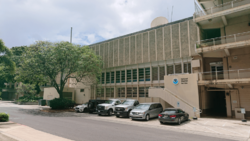Central Pacific Hurricane Center facts for kids
 Front view of the Central Pacific Hurricane Center |
|
| Agency overview | |
|---|---|
| Jurisdiction | United States government |
| Headquarters | Honolulu, Hawaii, U.S. 21°17′55″N 157°49′00″W / 21.29861°N 157.81667°W |
| Parent agency | NOAA |
The Central Pacific Hurricane Center (CPHC) is a special office in the United States that helps keep people safe from tropical cyclones. It's part of the National Weather Service. The CPHC watches for hurricanes and tropical storms in the middle part of the Pacific Ocean, especially near Hawaii. It gives out important warnings and updates. Because of its important job, it's also known as RSMC Honolulu.
The CPHC is located in Honolulu, Hawaii. It shares a building with the National Weather Service's Honolulu office on the campus of the University of Hawaii at Mānoa. The CPHC starts its work when tropical cyclones appear or move into its area. This center took over from an older office, the Joint Hurricane Warning Center, starting in the 1970 hurricane season.
Contents
What Area Does the CPHC Cover?
The CPHC is in charge of a specific part of the Pacific Ocean called the Central Pacific (CP) region. This area is defined for administrative reasons, not just for weather patterns. It stretches from the equator northwards, between 140°W and 180°W longitude.
Even though it's not a natural "basin" where storms always form, people often call it the Central Pacific basin. The western edge of this area, 180°W, is very close to the International Date Line.
How Does the CPHC Area Fit with Other Regions?
Weather-wise, the CPHC's area covers the western part of the Eastern Pacific basin and the eastern part of the Western Pacific basin. However, other weather centers handle different parts. The National Hurricane Center (NHC) is responsible for the Eastern Pacific basin east of 140°W.
The hurricane season in the Central Pacific usually runs from June 1 to November 30 each year. Storms can form in the Eastern Pacific and move west towards Hawaii. They can also form in the Western Pacific and move west towards Asia. Sometimes, smaller islands in the Central Pacific are affected, but this region is mostly empty ocean.
How Are Hurricanes Named in the Central Pacific?
| List 1 | List 2 | List 3 | List 4 |
|---|---|---|---|
| Akoni | Aka | Alika | Ana |
| Ema | Ekeka | Ele | Ela |
| Hone | Hene | Huko | Halola |
| Iona | Iolana | Iopa | Iune |
| Keli | Keoni | Kika | Kilo |
| Lala | Lino | Lana | Loke |
| Moke | Mele | Maka | Malia |
| Nolo | Nona | Neki | Niala |
| Olana | Oliwa | Omeka | Oho |
| Pena | Pama | Pewa | Pali |
| Ulana | Upana | Unala | Ulika |
| Wale | Wene | Wali | Walaka |
The Central Pacific Hurricane Center uses traditional Hawaiian names for hurricanes that form in its area. They have four different lists of names. When all the names on the first list are used, they move to the second list, then the third, and then the fourth. After the fourth list, they go back to the first one again.
Unlike some other regions, the names do not start over at "A" every year. A few names have been "retired" because the storms they represented caused a lot of damage. These retired names include Iwa (1982), Iniki (1992), Paka (1997), and Ioke (2006). New names replaced them: Io (later changed to Iona), Iolana, Pama, and Iopa. The names Iona and Keli were used during the 2025 hurricane season.
How Does the CPHC Forecast Storms?
Since the 1990s, the CPHC has used a special computer system called the Automated Tropical Cyclone Forecasting System. This system helps them create forecasts, warnings, and maps about tropical cyclones.
See also
 In Spanish: Centro de Huracanes del Pacífico Central para niños
In Spanish: Centro de Huracanes del Pacífico Central para niños
- Joint Typhoon Warning Center (JTWC)


